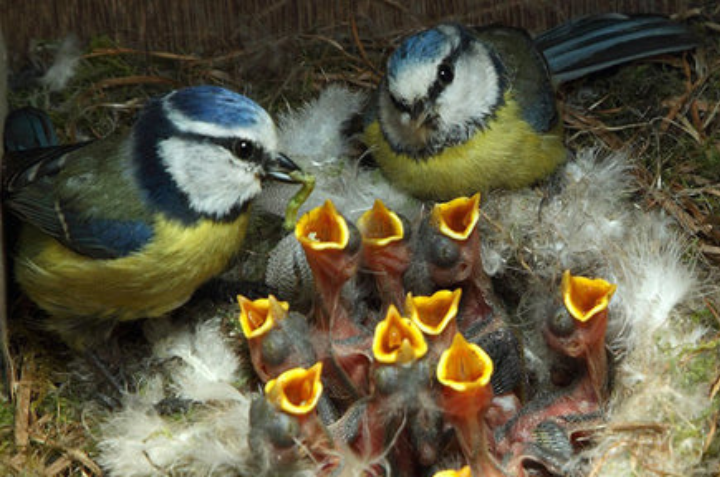May and June are by far the busiest months for blue tits - with hatching eggs and their young growing bigger by the day, the demand for food is constant. These two months mark the end of their breeding season, but blue tits start thinking about breeding as early as February. Great tits, however, breed around 7-10 days earlier than blue tits.
During the final months of winter, blue tits regularly spend the night in bird boxes, so it is important to install a bird box in late autumn (around November) to encourage birds to nest there in the spring.
February/March: Finding a Nesting Site
This is the time to find a safe and warm nesting site to raise their chicks. The location is important - there must be a clear flight path to the entrance hole and it must be relatively inaccessible to predators. Finding the right mate is also a top priority at this time!
March: The Need for Additional Energy
Birds need to be in excellent condition at the start of the breeding season - peanuts, black sunflower seeds and suet are a valuable source of nutrients. The energy provided by this extra food will be used to produce the eggs and keep the parents in good condition, so they are able to provide sufficient food for their chicks.
April: Nest Building by the Female
The female blue tit builds the nest by herself, with little or no help from the male. Moss will be taken from the lawns in the garden and formed into a cup. You will know that the nest is complete and ready for laying when it is lined with soft feathers, fur or wool. Blue tits can build a nest in a few days, but it usually takes between one and two weeks.
Early May: Multiple Egg-Laying
This is an exhausting period for the female blue tit, as she lays an egg a day, usually first thing in the morning. The blue tit has one of the largest clutches of any bird - sometimes laying up to 16 eggs, although most clutches contain 8-12.
Mid-May: Two Weeks Brooding
The female plucks feathers from her abdomen to create a bare area (called a brood patch) to incubate the eggs. She begins incubating the clutch the day before it is complete and stays on the eggs for about two weeks until they are ready to hatch. During this period, if she has made a good choice of partner, the male will provide food, but she will still have to leave the nest or nest box regularly during the day to feed.
Late May: Chicks Hatch
The chicks hatch naked and blind and are most vulnerable at this time. They need constant warmth, and the female will frequently sit on them. Finding enough food can be difficult if the weather is cold and wet. Feeding the chicks puts a strain on the parents, who come and go in the nest box with juicy, fat caterpillars.
Each chick can eat 100+ caterpillars a day, so the adults have to find up to 1,000 caterpillars a day for a clutch of 10! The chicks' feathers are now more developed and they are starting to look like they can fly!
Early June: The Chicks' First Flights
When the chicks are ready to fly, the parents call them from outside the box, urging them to come out. One by one, each chick will stick its head out and make its first test flight - usually badly, and to the nearest available perch. Remember also, as the heat increases, to provide watering troughs or watering holes where they can drink or wash regularly.

June/July: Family Life & Their First Dangerous Encounters
Chicks stay with (and are fed by) their parents for a few weeks after fledging.
This is a dangerous time for young birds as they must learn to find food and avoid predators quickly if they are to survive.
WiFi Nest Box Camera
We offer a range of nest box camera systems to get you up close and personal to nesting birds like blue tits in your own garden. Watch live or record on your phone or tablet as your birds build a nest, lay eggs and raise their chicks. Click here to check out our WiFi Nest Box camera Systems.





